but-的用法
- 格式:doc
- 大小:32.00 KB
- 文档页数:13
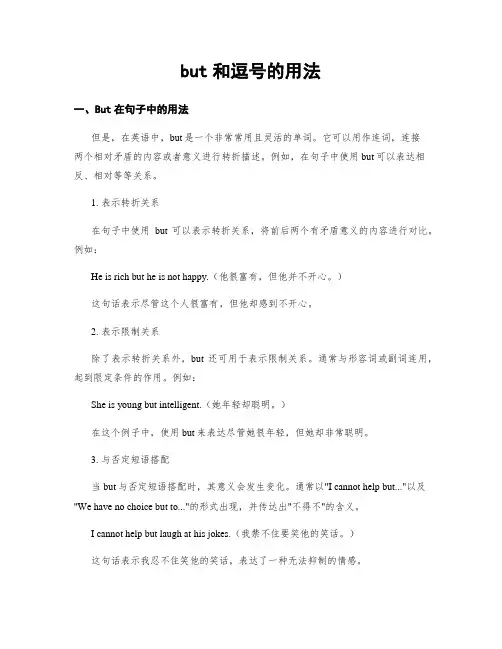
but和逗号的用法一、But在句子中的用法但是,在英语中,but是一个非常常用且灵活的单词。
它可以用作连词,连接两个相对矛盾的内容或者意义进行转折描述。
例如,在句子中使用but可以表达相反、相对等等关系。
1. 表示转折关系在句子中使用but可以表示转折关系,将前后两个有矛盾意义的内容进行对比。
例如:He is rich but he is not happy.(他很富有,但他并不开心。
)这句话表示尽管这个人很富有,但他却感到不开心。
2. 表示限制关系除了表示转折关系外,but还可用于表示限制关系。
通常与形容词或副词连用,起到限定条件的作用。
例如:She is young but intelligent.(她年轻却聪明。
)在这个例子中,使用but来表达尽管她很年轻,但她却非常聪明。
3. 与否定短语搭配当but与否定短语搭配时,其意义会发生变化。
通常以"I cannot help but..."以及"We have no choice but to..."的形式出现,并传达出"不得不"的含义。
I cannot help but laugh at his jokes.(我禁不住要笑他的笑话。
)这句话表示我忍不住笑他的笑话,表达了一种无法抑制的情感。
4. 强调对比在某些情况下,使用but可以强调对比。
例如:The book is expensive, but it's worth every penny.(这本书很贵,但它物有所值。
)这句话中,but用来突出前后两个句子之间的对比,表达尽管这本书价格高昂,但它确实物有所值。
二、逗号在句子中的用法逗号作为标点符号,在英语写作中起着非常重要的作用。
它有多种用法,能够帮助我们更好地表达和传达信息。
1. 分割并列元素一个十分常见而且容易理解的用法是将并列元素分隔开来。
例如:I like reading, writing, and painting.(我喜欢阅读、写作和绘画。

and,but的用法一、引言词汇是语言中的基本组成单位,而连词则是连接各个组成单位的重要元素。
在英语中,常见的两个连词是 "and" 和 "but"。
这两个连词在句子中扮演着不同的角色和功能,正确使用它们可以帮助我们表达清晰、准确的意思。
本文将详细讨论"and" 和 "but" 的用法,并提供实例展示其灵活性和特征。
二、 "and" 的用法1. 连接相似事物或并列句:"And" 通常被用来连接两个相似的事物或并列句,表示它们具有同等重要性。
例如:- I like to read books and watch movies.我喜欢读书和看电影。
- She is smart, beautiful, and kind.她聪明、美丽又善良。
2. 在列举时使用:"And" 能够帮助我们清晰地列举多个事物。
例如:- We need eggs, milk, butter, and sugar for the recipe.我们需要鸡蛋、牛奶、黄油和糖来做这道菜。
- He has been to China, Japan, Thailand, and Korea.他去过中国、日本、泰国和韩国。
3. 表示递进关系:当两个相似事物之间存在递进关系时,我们可以使用 "and" 来表达这种关系。
例如:- The storm grew stronger and the wind blew harder.暴风雨越来越猛烈,风也越刮越大。
- She studied hard and achieved excellent results.她努力学习,并取得了优异成绩。
三、 "but" 的用法1. 表示对比或转折:"But" 通常被用来引导一个转折或对比的观点。

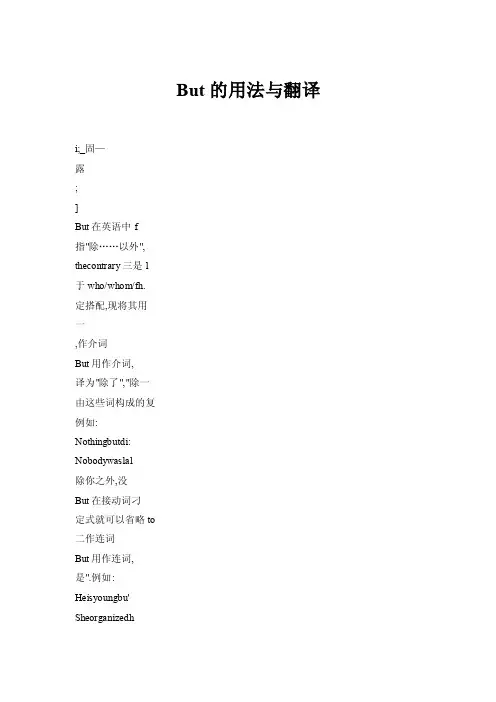
But的用法与翻译i;_固—露;]But在英语中f指"除……以外",thecontrary三是l于who/whom/fh.定搭配,现将其用一,作介词But用作介词,译为"除了","除一由这些词构成的复例如:Nothingbutdi:Nobodywaslal除你之外,没But在接动词刁定式就可以省略to二作连词But用作连词,是".例如:Heisyoungbu'Sheorganizedh她筹划了自己f在but用作连诟heisonlyachild,bu应改为:AlthoughIBut用作连词连词that,故不必ThereisnodoulThere'Snoquest三,作副词But用作副词,相当于only,常译为"只","才","不过","仅仅".例如: Heleftbutafewminutesago.他几分钟前才离开.Sheisbutayounggir1.她只不过是个小女孩.Tomtoldbutonestory.汤姆只讲了一个故事.四,作关系代词But除了用作介词,连词,副词之外,还可以充当准关系代词,引导定语从句,表示从属关系,它本身含有否定的意思,作用相当于who/whom/that/which…not…,其前的主句须有否定词,如no,not,little,few,hardly等,整个句子表示双重否定.例如: Thereisnomanbuterrs.=Thereisnomanwhodoesnoterr.没有任何人是不会犯错误的. Thereisnomotherbutlovesherownchildren.=Thereisnomotherthatdoesnotloveherownch ildren.=Everymotherlovesherchildren.没有不爱自己子女的母亲. Thereisnooneofusbutwishestogo.=Thereisnooneofuswhodoesnotwishtogo.我们人人都想去.Thereisnorulebuthasexceptions.=ThereisNOrulethathasnoexceptions.凡规则都会有例外.'五,作名词But用作名词的情况较少见,但在口语中还是存在,表"反对"之义.例如: Butmenobuts.别老是跟我说"但是","但是"了.DoasItellyou,nobutsaboutit.照我讲的去做,不得反对.六,But的固定搭配I.allbut译为"几乎","差一点".例如:Theroomwasallbutempty.房间里几乎全空了.2.anythingbut译为"根本不","决不".例如:1wasanythingbuthappyaboutgoing.我根本不喜欢去.3.butfor表让步关系,相当于一个虚拟条件,译为"多亏","要不是",常用于虚拟语气句中.例如:Butforyourhelp,1wouldn'thavesucceeded.要是没有你的帮忙,我就不会成功.4.butthat相当于exceptthat,译为"若非","要不是",也用于虚拟语气句中.例如: Theywouldhaveresistedbutthattheylackedcourage.要不是缺乏勇气,她们会抵抗的.5.butnOW译为"刚刚","适才".例如:ButnowIchangedmyidea.我刚刚改了主意.6.butthen译为"但另一方面","不过".例如:Shewasearly,butthenshealwaysis.她来得早,不过她总是早来.7.can(could)but译为"只能","只好".例如: Theoldmancanbutwalkslowlywithastick.老人只能拄着拐杖慢慢走.词汇与语法8.cannot(couldnot)helpbut后接动词原形,译为"不得不","忍不住".例如: Heissuchanunselfishman.Y oucannothelpbutrespecthim.他是这样一个毫无私心的人,你不得不尊敬他.9.cannot(couldnot)but译为"不得不","必然","不能不".例如: Itwasarashthingtodo,yetonecannotbutadmirehercourage.这事做得过于鲁莽,然而不能不佩服她的勇气.10.cannot(couldnot)choosebut译为"不得不","只好".例如: Hecouldnotchoosebutleaveherchildrenathome.他不得不把孩子们留在家里.l1.never…but…译为"一……就……","每当……就(总)是……".例如: Mybrotherneverwritestomyparents,butheasksthemformoney.每当我兄弟写信给父母时,就是向他们要钱.12.nonebut译为"只有".例如:Nonebutthebravedeservesthefair.只有英雄才配得上美人.13.notonly…butalso…译为"不但……而且……","不仅……还……","既……又……".例如:Notonlyisthisyoungmancleverbutalsoheishardworking.这个年轻人不仅聪明,而且还很努力. Notonlyshebutalsohersisterslikeplayingthepiano.不仅她,而且她的姐妹们都喜欢弹钢琴.当notonly位于句首引导分句时,分句中的主语和谓语要倒装.当notonly…butalso 用于连接两个并列主语时,谓语动词应与就近的主语保持一致.14.not…but…译为"不是……而是……".例如: Theplancausednotprosperitybutruin.这个计划带来的不是繁荣而是毁灭.l5.nothingbut译为"只","只不过","仅仅".例如:Iamnothingbutateacher.我只是个教师.16.thefirstbutone(two,three…)译为"第二(三,四……)".例如: InthebrothersMr.Kongwasthefirstbutone.孔先生在弟兄中排行老二.l7.thelastbutone(two,three…)译为"倒数第二(三,四……)".例如: Pleasereadthelastbutoneparagraph.请阅读倒数第二段.18.thenextbutone译为"下下一(个)".例如: Shelivedinthenextbutonehousetome.她住在我隔壁的隔壁.以上为but作为五种词类及固定搭配的用法.用作介词时,相当于except;用作连词是较常见的用法,表转折义;用作副词时,相当于only;用作关系代词时,含有否定之义,应是学习的重点与难点;but用作名词的情况虽有,但不多见.另外,but的固定搭配皆有固定的含义,只需稍加用心记忆,便可掌握.英语露学。
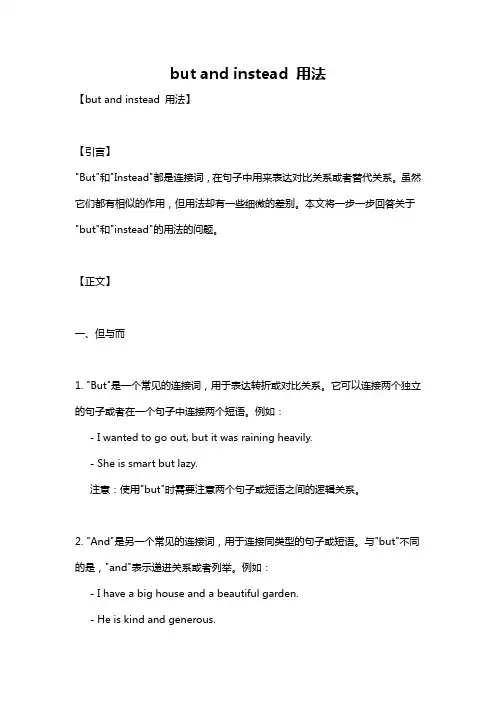
but and instead 用法【but and instead 用法】【引言】"But"和"Instead"都是连接词,在句子中用来表达对比关系或者替代关系。
虽然它们都有相似的作用,但用法却有一些细微的差别。
本文将一步一步回答关于"but"和"instead"的用法的问题。
【正文】一、但与而1. "But"是一个常见的连接词,用于表达转折或对比关系。
它可以连接两个独立的句子或者在一个句子中连接两个短语。
例如:- I wanted to go out, but it was raining heavily.- She is smart but lazy.注意:使用"but"时需要注意两个句子或短语之间的逻辑关系。
2. "And"是另一个常见的连接词,用于连接同类型的句子或短语。
与"but"不同的是,"and"表示递进关系或者列举。
例如:- I have a big house and a beautiful garden.- He is kind and generous.注意:使用"and"时需要确保连接的是相似的信息或想法。
二、但是与然而"But"和"However"都可以表示转折关系,但是"However"更加正式一些。
它在写作中常用于表达句子或段落之间的逻辑关系。
例如:- I was tired. However, I continued working.- She is talented. However, she lacks confidence.三、但是与而是"But"和"Rather"都可以表达转折或对比关系,但是含义略有不同。
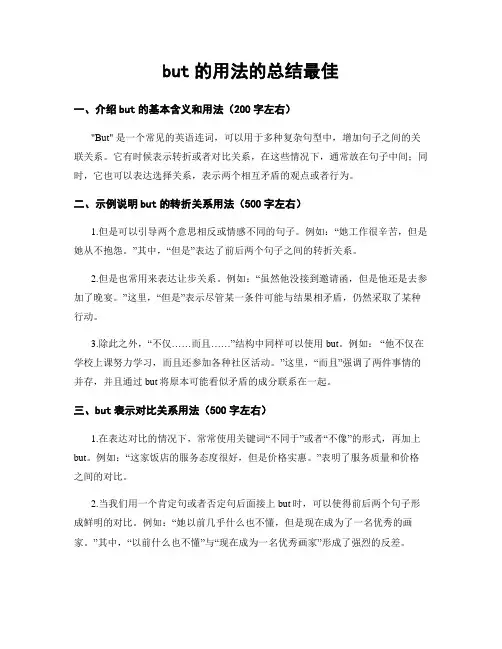
but的用法的总结最佳一、介绍but的基本含义和用法(200字左右)"But" 是一个常见的英语连词,可以用于多种复杂句型中,增加句子之间的关联关系。
它有时候表示转折或者对比关系,在这些情况下,通常放在句子中间;同时,它也可以表达选择关系,表示两个相互矛盾的观点或者行为。
二、示例说明but的转折关系用法(500字左右)1.但是可以引导两个意思相反或情感不同的句子。
例如:“她工作很辛苦,但是她从不抱怨。
”其中,“但是”表达了前后两个句子之间的转折关系。
2.但是也常用来表达让步关系。
例如:“虽然他没接到邀请函,但是他还是去参加了晚宴。
”这里,“但是”表示尽管某一条件可能与结果相矛盾,仍然采取了某种行动。
3.除此之外,“不仅……而且……”结构中同样可以使用but。
例如:“他不仅在学校上课努力学习,而且还参加各种社区活动。
”这里,“而且”强调了两件事情的并存,并且通过but将原本可能看似矛盾的成分联系在一起。
三、but表示对比关系用法(500字左右)1.在表达对比的情况下,常常使用关键词“不同于”或者“不像”的形式,再加上but。
例如:“这家饭店的服务态度很好,但是价格实惠。
”表明了服务质量和价格之间的对比。
2.当我们用一个肯定句或者否定句后面接上but时,可以使得前后两个句子形成鲜明的对比。
例如:“她以前几乎什么也不懂,但是现在成为了一名优秀的画家。
”其中,“以前什么也不懂”与“现在成为一名优秀画家”形成了强烈的反差。
3.同时,在引导并列句时,可以使用but来强调两种选择或观点之间的区别。
例如:“有些人喜欢夏天游泳,而有些人却更喜欢冬天滑雪。
”这里,“而”本身相当于but,并且突出了夏天游泳和冬天滑雪之间的选择性。
四、总结but的各种用法(200字左右)“But” 是一个极其常见且灵活多变的连词,在英语写作中经常被使用。
它可以引导转折关系,表达对比关系,以及选择关系。
通过合理运用but,能够增加句子之间的逻辑连贯性,使文章更加丰富有力。

在英语中,我们都知道but是表示转折的,但是你可不能小看它哦,除此之外,还有以下几种常见用法:一、but用法连词,表示让步关系,意思是“除非,要不是”,常与that一起构成but that, 相当于"if...not"。
例如:I would have failed but that your helped me.要不是你们帮助我,我就会失败。
二、but用作连词,放在否定词或疑问词之后,作从属关系,表示否定意义,可相不于that not.例如:Never a month passed but she writes to her parents.她没有一个有不给她双亲写信。
三、but用于否定词加doubt,question,deny等到之后,没有实在意义,只相当于关系连词that.例如:There's no doubt but he is a thief.毫无疑问,他是一个贼。
四、but用作介词,表示“除了”意义,相当于besides,except.例如:No one knows him but she.除了她,没有人认识她。
五、but用作副词,相当于only, 常译为“只不过,仅仅”。
例如:He finished his homework but ten minutes ago.他十分钟前刚完成作业。
六、buy用作代词,表示从属关系,在否定句中常相当于who/that not.例如:There is no one but likes to help him.没有人不认识他。
动词搭配1. add to增加,增进add … to把…加进…add up相加add up to总计,所有这一切说明1) I don't think these facts will ________ anything.2) Fifty new books have been ________ the library.3) The music _________ our enjoyment of the film.4) You must have made a mistake when you _______ the bill ________.( add up to, added to, add to, added…up )2. break away from打破,脱离,挣脱,改掉break down出毛病,身体(精神)衰弱,分解,拆开break off暂停,中断break in强行进入,插话break into闯入break into pieces成为碎片break out爆发break up捣碎,驱散,瓦解,学期结束,拆散break through突破1) The criminal managed to break _______ ______ the police and ran into the woods.2) When he heard the news, he broke _______ and cried.3) Don't break ________ while others are speaking.4) Why don't you break ________ for a few minutes and have some coffee?5) When does school break ________?6) After harvest we break _________ the soil with a tool pulled by two oxen. ( away from, down, in, off, up, up )3. bring up抚养,呕吐,提出bring about造成bring out拿出,出版bring in引入,引进,挣钱bring back使回想起bring down使下降,使倒下1) The shopkeeper brought his price _________ to only five dollars.2) The school has brought _________ new foreign teachers to teach oral English.3) The song brought ___________ happy memories of our schooldays.4) Do you know what brought ___________ this misunderstanding?5) The kind old man agreed to bring __________ the young orphan.6) We decided to bring the matter ___ at the next meeting.7) The wind brought _______ a lot of trees last night.8) Next month they will bring ________ a new edition of the book.( down, in, back, about, up, up, down, out )4. call on号召,拜访(某人)call at拜访、参观(某地)call for去叫某人, 要求, 需要call up使回忆起, 征召入伍call in召集,请某人来call out大喊,高叫call off取消,不举行1) Doctors are often called _____ in the middle of the war.2) Please wait for me at home. I'll call _______ you at your house at seven tonight.3) The trains calls _______ several big cities between Beijing and Guangzhou.4) He called her name __________, but she didn't answer.5) The sports meet was called ____ on account of the rain.( in, for, at, out, off)5. come about发生,出现come down下跌,落,降,传下来come in进来come into (sight/being/existence/use/notice/effect)come on来临/ 快点come out出版,结果是come along一道来,赶快come to达到(an end/an agreement/a stop)苏醒,合计,总共是come over走过来come up发芽,走近come across偶然碰到come back回想起come from来自,源自1) I come _________ the book I lent you last month.2) How did it come _________ that you both got lost? I thought you had a map.3) It suddenly came _________ to me where I had seen the boy before.4) Come __________ now, or else we shall be late.5) He came __________ me like a tiger.6) The price of petrol has come _________ since the beginning of this year.7) The word came __________ use many years ago.8) When the examination result came _________, he had already got a job.9)The bill came __________ over a thousand dollars.10) I sowed the seeds over a month ago, but they haven't come __________ yet. ( for, about, back, on, at, down, into, out, to, up )6. cut across抄近路cut down砍倒,削减cut off切断,割掉,断绝关系cut up连根拔除,切碎through剪断,凿穿cut out删(省)掉,戒掉cut in插嘴1) Don't cut ___ this tree. It will be very shady in summer.2) You must cut ________ the number of cigarettes you smoke, or it will cause illness.3) We decided to cut _________ the moor(旷野)to the village.4) Cutting the tree ____ means cutting the tree into pieces.5) The electricity was cut ___________ when the lady refused to pay the bill.6) We were having a pleasant conversation when T om cut __________.(down, down, across, up, off, in )7. die of (disease/hunger/grief/old age)死于(疾病,饥饿,寒冷,情感原因)die from死于(意外事故、情形)die away渐渐消逝die out绝种die down(炉火)渐熄die off逐一死去8. fall behind落后fall over one's feet 跌跤fall down掉下,跌倒fall back撤退,后退1) Babies often fall _____ when they are learning to walk.2) Our team seems to have fallen __________ the others.3) As soon as the enemies fell __________, the people returned to their village.4) She fell__________ the bench and had her leg broken.(down, behind, back, over )9. go in for从事,喜爱,参加go through通过,经受go over复习,检查go up(价格)上涨,建造起来go after追捕,追赶go against违反go ahead先行,开始吧,问吧,说吧go away离开go by时间过去go down下沉,降低,(日、月)西沉go on(with)继续进行go with相配,陪同go without没有,缺少go out外出,熄灭go all out全力以赴go off爆炸,进行,变坏,断电,停止供应go back on背约,食言go beyond超出1) Many new factories have gone __ in the past few years.2) Rents have gone __________ greatly recently.3) Many years have gone ___________ since we first met.4) Let's continue our journey until the sun goes _______.5) His actions went ___________ the will of the people,6) I can't do it, for it goes ___________ my duty.7) Over 100 students went ____________ this entrance examination.8) The bomb went ____________ and killed ten people.9) The buyer went ___________ the car carefully before reaching a decision.10) This tie doesn't go ___________ my blue shirt.11) If you think you can solve the problem, go ______.12) Many students went __________ playing basketball.(up, up, by, down, against, beyond, through, off, over, with, ahead, in for ) 10. get down下来,记下,使沮丧get down to致力于,专心于get on进展,进步,穿上,上车get off脱下,下车get in收集,插(话)get away逃跑,逃脱,去休假get over忘记,越过,克服,从疾病中恢复get along with进展,相处get up起床get through打通电话,完成,通过get round消息传开get close to sth. 接近,几乎get into (trouble)get to (know)get back取回,收回get out1) She spoke so fast that I couldn't get ____ what he said.2) We will find ways to get _________ difficulties.3) The story has got __________, and everyone knows about it.4) When I get _________ with the report, I'll go to the cinema.5) After a delicious meal the two men got __________ to business.6) Don't always get __________ a word when others are speaking.7) It took me a long time to get ___________ such an unpleasant experience. (down, over, round, through, down, in, over)11. give away赠送,泄露,出卖give out发出,疲劳,分发,公布give off发出(光、热、气体)give in (to sb.) 屈服give up放弃,让(座位)1) His accent at last gave him __________.2) The liquid gave ________ a strong smell.3) The headmaster gave ___________ the names of the prize-winners.4) The soldiers gave _________ the town to the enemies.5) Who will help me to give the books ___________?6) Don't believe in those who give his friends ________.7) After a long walk, my strength gave ____________.(away, off, out, up, out, away, out)12. hand in交上,提交hand out分发hand down流传,遗传13. hang about闲逛hang up挂电话14. hold back阻止,隐瞒hold up举起,使停顿hold on别挂电话,等,坚持hold out持续,坚持,伸出hold down控制,镇压1) I'm sure he is holding something _________.2) She managed to hold ______ her emotion until her guests had left. Then she cried.3) Tell him to hold ________ a moment. I'll come soon.4) Our food supply won't hold _________ for more than a few days.5) The train was held ________ as a result of the floods.6) These measures helped to hold ___________ the city's population.7) Hold ___________ your left arm, please.(back, back, on, out, up, down, up)15. keep up (courage, English, spirits)保持,keep up with跟上keep off (grass)不接近,离开keep away from避开,不接近,离…远远的keep out ofkeep to (rules, promise)坚持,遵守keep on继续,坚持下来keep back阻止,留下,隐瞒,扣下keep from克制,阻止1) The angry lady told the strangers to keep ________ from her.2) I can hardly keep ________ my tears after hearing his words.3) Only pride kept her __________ bursting into tears.4) I can scarcely keep __________ asking him what he has done.5) "Don't touch me," screamed the woman, "Keep __________!"6) Keep _________ until you succeed.7) Keep _________ your courage, and you'll succeed in the end.8) The thick coat can keep the cold ___________.9) Always try to keep ___________ the rules when you play a game.10) I can't keep ________ with everything you're doing. (away, back, from, from, off, on, up, out, to, up)16. knock at/on敲knock into撞到某人身上knock down撞倒knock out of把…敲出knock over撞倒knock off停止工作,休息1) The boxer soon knocked his opponent _________.2) The office stuff knocks _________ at six every day.3) Try knocking __________ the window and see if there is anyone indoors.4) He was so absorbed in his book that he knocked __________ the car parked there. (down, off, on, into)17. leave for离开前往leave out删去,遗漏leave behind遗留,忘记拿走leave to留给,遗嘱赠于leave over遗留,剩下,延期1) "Whose name has been left __________?" demanded the teacher.2) When he died, he left all his property _____ his niece.3) He suddenly realized that he had left his umbrella ___________.4) Don't leave this matter _________ until tomorrow.5) Leave some meat ___________ for tomorrow.6) Those are questions left _________ by history.(out, to, behind, over, over, over)18. look up查找,向上看look through翻阅,浏览look on旁观look on…as看作look into调查look after/ at / for 照顾/看/寻找look out(for)当心look about / around/round四下查看look down upon瞧不起look back upon回忆,回顾look ab. up and down仔细打量某人look ab in the face/eyes直视某人1) I spent two hours looking ______ the students' papers.2)Look _______! There is a big hole in front.3) He took part in the game, and the rest of us just looked ______ and cheered for him.4) The old man looked _____ upon the days of his youth.5) She was so snobbish(势利)that she looked __________ upon all his neighbours.6) The police promised to look __________ the case as soon as possible.7) He looked __________ but saw nobody, and he listened but hear nothing. (through, out, on, back, down, into, about/around/round)19. make up编造,配制,打扮,组成make up for弥补make into / of / from 制成make out弄懂,发现,看出,填写,开列(清单)make for走向,驶往,促使1) Can you make this length of cloth __________ a suit?2) I asked the driver if he was making ___________ London?3) My father made __________ a check for me to buy the camera.4) We must make the loss _________ next week./ He tried hard to make ________ for the damage he had done.5) He made __________ a story, which I found hard to believe.6) Someone is coming, but I can't make ___________ who it is.(into, for, out, up/up, up, out)20. pass away去世pass by经过pass down(on)…to传给pass through经历pass over漠视,忽视1) The old clock has been passed ________ to me from my grandfather's grandfather.2) The man passed ___________ last week in peace.3) We are passing ____________ difficult times.4) The secretary passed ___________ the details in the first part of his report. (down, away, through, over)21. pay back还钱,报复pay for付钱,为…受到惩罚,因…得到报应pay off还清1) How much did you pay __________ the dictionary?2) You should pay _________ the money you borrowed from me.3) I'll pay him ____________ for all his crimes(罪行) against me.4) Some day, you'll pay __________ what you have done today.5) Has she pay ____________ the debt yet?(for, back, back, for, off)22. pick up拾起,获得(information),接人,站起,收听,自然习得(language /knowledge),恢复重获(pick up health)pick out挑选,辨认,看出1) I picked the information __________ while waiting in the queue.2) My friend has arranged to pick me _________ at 6:00.3) The patient has picked _________ health during the last two weeks.4) She picked _______ the most expensive pair of shoes.5) I can't pick John ___________ in the crowd.6) Can I pick __________ VOA with this short-wave radio?7) He fell down suddenly, but picked himself ___________ quickly.(up, up, up, out, out, up, up)pick cotton/flower/leaves/words选词23. put up搭起,张贴,举起,安装,投宿,安排住下put up with忍受put out伸出,扑灭put off推迟put into放进,翻译put away放好,存钱put down记下,平息put on穿戴,上映,增加(put on weight/speed)put forward 提出,提前put through 接通电话put aside放到一边put back放回1) He put _________ half his wage every week.2) The government soon put __________ the revolt(暴乱).3) Put your watch __________. It's slow.4) He put __________ his hand for me to shake.5). Please put me __________ to Extension(分机)2.6) We put ___________ for night at the village inn.7) He is very proud, and he often put _________ airs.(摆架子)8) We had a telephone put _____________ in our office.9) I can't put __________ with your laziness.(away, down, forward, out, through, up, on, up, up)24. pull down拆掉,推翻pull on匆匆穿上/ off 脱pull in进站pull out取出,(火车)离站pull down往下拉,拆毁pull over驶到一边pull through恢复健康,渡过难关,脱离险境pull up(使)停住1) The train slowly pulled __________ and disappeared in the distance.2) All the old houses here have now been pulled ______, and new ones are to be built.3) The car pulled _________ when I blew the horn.4) The doctor thinks the man will pull __________.5) The driver pulled ________ at the traffic lights.(out, down, over, through, up)25. push over推倒,刮倒push ahead(on, forward)继续前进,坚持下去push through排除困难办好谋事,努力设法通过,挤过1) We've decided to push __________ with our plan to build a new road2) Many trees were pushed __________ in the hurricane.3) They were determined to push the new rules ________ at any cost..4) Take care not to push the baby _________.5) They pushed ___________ the crowd and at last reached us.(on, over, through, over, through )26. run across偶然碰到run after追逐,追捕run away逃跑run for竞选run into偶然碰到(困难)遇见(人),相撞run out of用完1) If you drive so fast, you'll run _________ someone some day.2) I ran __________ a friend of mine in the exhibition.3) Our water has run __________. Can you fill up some more bottles?4) Why do you always run __________ adventure?5) He didn't want to run ___________ president that year.6) In that way you will only run __________ difficulties.( into, across/into, out, after, for, into)27. see off送行see through看透,识破see to照料,照管28. send for派人去请send off送行send out发出(光亮)等send up发射29. set up建立set off出发,触发,引起set out动身,着手(to do),陈述set about开始着手(doing)set to work(n.)开始做set back拨回,使推迟1) I shall set my watch ___________ by five minutes.2) We set __________ reading the text aloud immediately the bell rang.3) We set _________ at daybreak yesterday and we've been travelling ever since then.4) I set __________ to advise him not to drink.5) What were the reasons he set ___________ in his report?6) The president set __________ a special group of soldiers to guard him.7) The unpopular law set _________ a series of protests.(抗议)(back, about, off/out, out, out, up, off)30. take off脱掉,起飞take on呈现雇佣take away拿走take in吸收,领会take up从事,占用(时间空间)take down记录,取下take back收回take for误认为take along随身带take over接管take out1) I take _________ all I said about his dishonesty.2) He went to the shelf and took __________ a book of poems.3) At first I took him _________ a doctor.4) I can see that most of you have taken ________ everything that the teacher taught.5) Bill has now taken __________ his father's business.6) My job takes __________ most of my time.7) The boss took ____________ twenty people for his new company.(back, down, for, in, over, up, on)take charge of负责, take sth. for granted想当然, take hold of抓住, take pride in 以… ……为自豪, take the place of, 代替take turns to do轮流做, take office就职31. think of想起think of…as把…看作think out想出think up想出think about考虑think over仔细考虑think well of sb. 对某人看法好32. turn off / on打开turn over翻身,反复考虑,翻(书页),翻转turn out证明为,结果,制造成品turn to转向,求助turn down调低,拒绝turn against变得敌视,反对turn away打发走,驱逐,转过脸去turn back返回,转回去turn round转过身来turn up向上翻,露面,出现,音量调大turn in上缴turn upside down把倒置,弄得乱七八糟1) The child turned __________ its mother for comfort.2) Turn ___________ and let me see your face.3) However much he turned the problem ________ in mind, he could find no satisfactory solution.4) The English evening party turned _________ a great success.5) The sight of the accident was too much for her to bear, and she turned _______.6) The football stadium was full, and many people had to be turned __7) The army turned him ___________ on account of (因为) his poor health.8) She turned the whole house ___________ in her search for her missing purse.9) Where did your purse turn ____________? I found it in the snow.10) The villagers suddenly turned __________ the foreigners who lived nearby.11) The factory turns ____________ 2000 new cars last year.(to, round, over, out, away, away, down, upside down, up, against, out)。
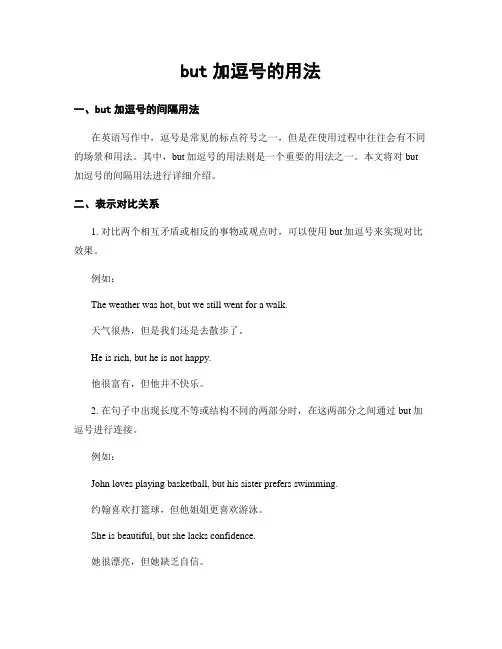
but加逗号的用法一、but加逗号的间隔用法在英语写作中,逗号是常见的标点符号之一,但是在使用过程中往往会有不同的场景和用法。
其中,but加逗号的用法则是一个重要的用法之一。
本文将对but 加逗号的间隔用法进行详细介绍。
二、表示对比关系1. 对比两个相互矛盾或相反的事物或观点时,可以使用but加逗号来实现对比效果。
例如:The weather was hot, but we still went for a walk.天气很热,但是我们还是去散步了。
He is rich, but he is not happy.他很富有,但他并不快乐。
2. 在句子中出现长度不等或结构不同的两部分时,在这两部分之间通过but加逗号进行连接。
例如:John loves playing basketball, but his sister prefers swimming.约翰喜欢打篮球,但他姐姐更喜欢游泳。
She is beautiful, but she lacks confidence.她很漂亮,但她缺乏自信。
3. 但是可以表示转折、修正或限制前面所说的内容。
例如:I wanted to go shopping, but I didn't have enough money.我想去购物,但是我没有足够的钱。
She worked hard, but she didn't achieve her goal.她很努力,但是她没有实现自己的目标。
三、表示转折关系1. 当一种情况发生时,但另一种情况突然出现或与之相反时,可以使用but加逗号来表示转折关系。
例如:He was tired, but he still managed to finish the project.他很累了,但还是设法完成了这个项目。
She studied hard for the test, but she failed in the end.她为考试努力学习,但最终失败了。
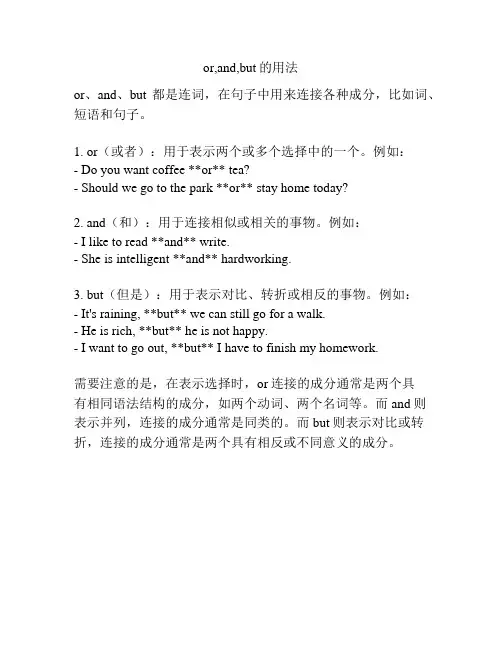
or,and,but的用法
or、and、but都是连词,在句子中用来连接各种成分,比如词、短语和句子。
1. or(或者):用于表示两个或多个选择中的一个。
例如:
- Do you want coffee **or** tea?
- Should we go to the park **or** stay home today?
2. and(和):用于连接相似或相关的事物。
例如:
- I like to read **and** write.
- She is intelligent **and** hardworking.
3. but(但是):用于表示对比、转折或相反的事物。
例如:
- It's raining, **but** we can still go for a walk.
- He is rich, **but** he is not happy.
- I want to go out, **but** I have to finish my homework.
需要注意的是,在表示选择时,or连接的成分通常是两个具
有相同语法结构的成分,如两个动词、两个名词等。
而and则表示并列,连接的成分通常是同类的。
而but则表示对比或转折,连接的成分通常是两个具有相反或不同意义的成分。
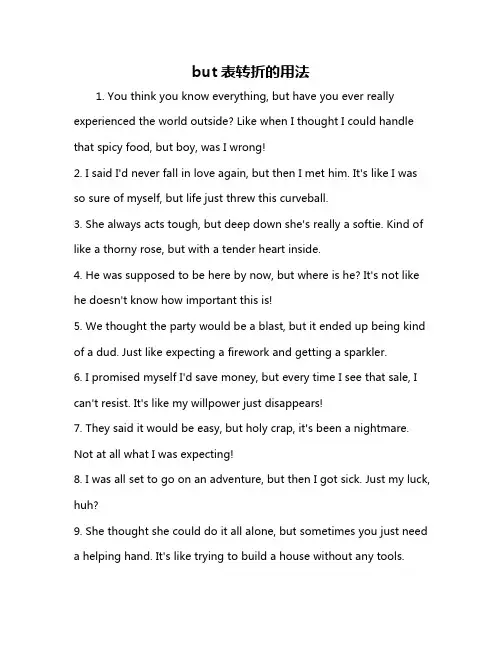
but表转折的用法1. You think you know everything, but have you ever really experienced the world outside? Like when I thought I could handle that spicy food, but boy, was I wrong!2. I said I'd never fall in love again, but then I met him. It's like I was so sure of myself, but life just threw this curveball.3. She always acts tough, but deep down she's really a softie. Kind of like a thorny rose, but with a tender heart inside.4. He was supposed to be here by now, but where is he? It's not like he doesn't know how important this is!5. We thought the party would be a blast, but it ended up being kind of a dud. Just like expecting a firework and getting a sparkler.6. I promised myself I'd save money, but every time I see that sale, I can't resist. It's like my willpower just disappears!7. They said it would be easy, but holy crap, it's been a nightmare. Not at all what I was expecting!8. I was all set to go on an adventure, but then I got sick. Just my luck, huh?9. She thought she could do it all alone, but sometimes you just needa helping hand. It's like trying to build a house without any tools.In conclusion, life is full of these "buts" that throw us for a loop or surprise us. It's what makes it interesting and keeps us on our toes. We can't always predict or control what comes after that "but", but we can learn to roll with the punches and make the best of every situation.。
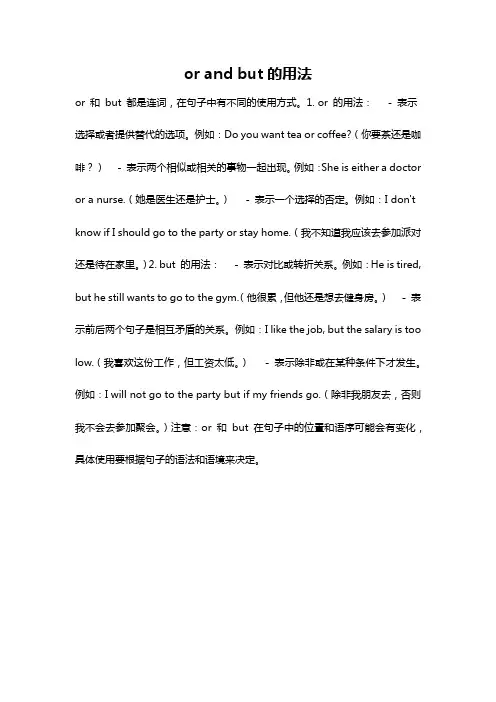
or and but的用法
or 和but 都是连词,在句子中有不同的使用方式。
1. or 的用法:- 表示选择或者提供替代的选项。
例如:Do you want tea or coffee?(你要茶还是咖啡?)- 表示两个相似或相关的事物一起出现。
例如:She is either a doctor or a nurse.(她是医生还是护士。
)- 表示一个选择的否定。
例如:I don't know if I should go to the party or stay home.(我不知道我应该去参加派对还是待在家里。
)2. but 的用法:- 表示对比或转折关系。
例如:He is tired, but he still wants to go to the gym.(他很累,但他还是想去健身房。
)- 表示前后两个句子是相互矛盾的关系。
例如:I like the job, but the salary is too low.(我喜欢这份工作,但工资太低。
)- 表示除非或在某种条件下才发生。
例如:I will not go to the party but if my friends go.(除非我朋友去,否则我不会去参加聚会。
)注意:or 和but 在句子中的位置和语序可能会有变化,具体使用要根据句子的语法和语境来决定。
but 和and的用法一、but和and的用法作为英语学习者,我们都知道“but”和“and”是两个常见的连词。
它们在句子中起着很重要的连接作用,可以改变句子的意思和结构。
但是,很多人对于这两个连词的正确使用还感到迷惑。
本文将详细解释“but”和“and”的用法,并提供一些实例来帮助大家更好地理解。
二、并列连接1. “And”的用法“And”是最常见的并列连词,它用于对两个或多个相似的事物、观点或动作进行连接。
例如:- I like to read books and watch movies in my free time.- She is kind and generous.- The sun was shining, and the birds were singing.可以看出,“and”表达了同一个主题下不同而相似的元素之间的关系。
使用“and”,整个句子反映了一个总体概念。
2. “But”的用法“But”与“and”类似,也是一个并列连词,但其使用场景略有不同。
“But”通常用来表示对比、转折或否定关系,在句子中起着承接前文并引导后文转变方向的作用。
例如:- He is smart, but she is even smarter.- I like coffee, but I don't like tea.- The weather was hot, but they still enjoyed their hike.可以看到,“but”连接的两个部分通常对比、转折或否定彼此,形成一个逻辑上的对比关系。
三、转折和对比1. 转折和对比通过使用“but”,我们可以在句子中表达对比,将两个相对的观点或情况进行清晰的区分。
例如:- She is hardworking, but she often procrastinates.- He works in a top company, but his salary is not ideal.- The hotel has a great location, but the service needs improvement.这些例子中,“but”连接了两个描述相反或不同的事物,突出了它们之间的差异,强调转折关系。
but和and的用法但是和并且的用法一、引言在英语中,连接词是非常重要的一部分,它们可以帮助我们将句子、段落或文章中的不同部分联系起来。
而其中两个常见的连接词就是“但是”(but)和“并且”(and)。
本文将探讨这两个连接词的正确用法,帮助读者更好地理解它们在不同语境下的用法和差异。
二、对比差异1. 语法角度“但是”(but)通常用于连接两个相对矛盾或相反的想法,表示转折。
它经常出现在句子中间,将两个相对矛盾或相反的观点进行对比。
例如:- I wanted to go out, but it was raining heavily.- She's very smart, but she can be lazy sometimes.“并且”(and)则用于连接两个相似或相关的想法,表示继承或补充。
它通常出现在句子之间,逐渐增加信息。
例如:- He is hardworking and intelligent.- They went shopping and bought a lot of things.2. 上下文角度上下文也会对“但是”和“并且”的使用产生影响。
“但是”更加强调前后发生了转变或有意外情况发生,“并且”则更加强调一种顺序递进或附加信息。
例如:- I wanted to go out, but it was raining heavily.(前后情况相反)- She loves music, and she also enjoys dancing.(两者有递进关系)三、使用示例1. 但是的使用示例- I want to buy a new car, but I don't have enough money.- He is a talented musician, but he lacks confidence when performing on stage.- She studied English for many years, but she still finds speaking difficult.2. 并且的使用示例- He went to the supermarket and bought some milk and bread.- They visited the museum, and they also explored the nearby park.- She enjoys playing soccer and swimming in her free time.四、注意事项1. 句子平衡性:当使用“但是”时,应确保前后观点在逻辑和语义上是相对矛盾或相反的;而在使用“并且”时,应确保前后观点在逻辑和语义上是相关或递进的。
and,but,or,so的用法
and,but,or,so是英语中常见的连词,它们可以连接两个句子或短语,使得整个句子更加流畅和连贯。
下面是它们的用法:
1. and
and用来连接两个相似或相关的事物,表示并列关系。
例如: - She likes coffee and tea. (她喜欢咖啡和茶。
)
- We played basketball and soccer yesterday. (昨天我们打了篮球和足球。
)
2. but
but用来连接两个相反或对比的事物,表示转折关系。
例如: - He is smart but lazy. (他很聪明但很懒。
)
- The movie was good but the popcorn was too salty. (电影不错,但爆米花太咸了。
)
3. or
or用来连接两个不同的选择或可能性,表示选择关系。
例如: - Would you like coffee or tea? (你想要咖啡还是茶?)
- You can wait here or go outside. (你可以在这里等待或者出去走走。
)
4. so
so用来连接原因和结果,表示因果关系。
例如:
- It's raining, so I'm not going out. (下雨了,所以我不出去。
)
- He studied hard, so he passed the test. (他努力学习,所以他通过了考试。
)
以上就是and, but, or, so的用法,希望对大家有所帮助。
but的用法推荐文章attribute的用法和短语例句热度:attribute是什么意思中文翻译热度: attribute的过去式和用法例句热度: distribute的过去式和用法例句热度: contribute的过去式和用法例句热度:but有但是等意思,那么你知道but的用法吗?下面跟着店铺一起来学习一下,希望对大家的学习有所帮助!but的用法大全:but的用法1:but的基本意思相当于in spite of this或表示与所预料的不一样,意为“但是,然而,尽管如此”,不与though,although 连用。
but的用法2:but可用来表达诸如愤怒、吃惊等强烈的感情,用来加强语气,也可用在表示歉意的句子里,常不译出,还可用于改变话题,意为“无论如何”“反正”“好”。
but的用法3:如果but接动词不定式,当前面有do或cannot时,不定式不带to; 当前面有anything, everything, nothing等词时,不定式常不带to,但也有例外; 其余情况带to。
but的用法4:与but连用的too...to do结构不具有否定意义。
but的用法5:如果主句含有hardly,never,never so,not so,not such等词,可用but,but that或but what引导表示结果的状语从句,构成双重否定,相当于that...not或unless,译作“没有…不”“若…,就一定”。
but的用法6:如果but that引出的分句描述的是真实情况,而主句描述的是非真实的情况,则主句多用虚拟语气,此时译作“假如没有…”“要不是”but的用法7:not but that...是it is not but that的省略法, but 无否定意义,译作“虽然…可是…”。
but的用法8:在not...but...结构里,可以不借助do(does)来否定动词,而否定其他成分,译作“不是…而是”。
英语语法词汇解析but作为关系代词用法but作为转折连词和介词的用法,很常见,很简单,前期文章多有论述,今天专门讲解这个词作为关系代词引导定语从句的用法。
引导定语从句的有who, whose, why, that, which, where 等关系代词和关系副词,但是but 也可以作为关系代词引导定语从句,今后应该是一个热门考点:1. but 作为关系代词引导定语从句时,一般用于否定句中,相当于who…not或that…not及which…not。
主句一般时否定句,而but 引导的出本身带有否定意味,这样就是双重否定来加强肯定语气。
but 在从句中可以作主语、宾语。
也就是说不必再加上其他词作主语或宾语了,即there is(are)no + 名词+ who(whom, which, that)…not= there is(are)no + 名词+ but……注意:定语从句中有be 动词保留be动词例:There is no one who is not interested in it.=There is no one but is interested in it没有人不对他感兴趣。
(but在从句中可以作主语)反过来,定语从句中有助动词(can,will,may,should…)保留该助动词。
There is nothing that he can not do.=There is nothing but he can do.没有什么事是他做不来的。
(but在从句中可以作宾语)定语从句中有do,does和did等助动词时,先去掉助动词,再依时态人称将之后的动词还原。
There is no book which he doesn't like to read.= There is no book but he likes to read..没有一本书是他不想看的。
There is no man but wants to spend Spring Festival with family.=There is no man who does not want to spend Spring Festival with family. 大家注意原句中用的是wants.没有一个人不想和家人一起过春节。
but加逗号的用法和例句一、介绍但是加逗号的用法在英语中,使用连词"but"可以表达对前面部分所说内容的转折、限制或对比。
而当我们想要更明确地强调这种转折关系时,可以在"but"之后加上一个逗号。
这种使用方式不仅可以提升句子的表达力,还能帮助读者更好地理解文本信息。
以下将详细介绍如何正确运用"but"加逗号,并结合丰富的例句来阐述这一用法。
二、表示对比关系1. 转折对比"But"加逗号常用于表达转折对比关系,在这种情况下,“but”之后的内容往往与前文形成鲜明的对照。
例句:She is beautiful, but her sister is even more stunning.她很漂亮,但她姐姐更加惊艳。
He studied hard for the test, but he still didn't get a good grade.他为考试努力学习了,但是成绩仍然不理想。
2. 替代选择另一种情况是当我们指出两个事物之间存在互斥、相反或替代关系时,也可以使用“but”加逗号。
例句:She wanted to go shopping, but she had to stay at home and finish her homework.她本想去购物,但她不得不留在家里完成作业。
I really enjoy swimming, but I can't swim today because the pool is closed for maintenance.我非常喜欢游泳,但是今天无法游泳,因为游泳池正在进行维护。
三、表示限制关系"But"加逗号还可以用于表达一种限制关系,这时它所引出的句子往往给出了前面内容的某种限定或条件。
例句:She loves chocolate, but she can only eat a small piece due to her dietary restrictions.她爱吃巧克力,但由于饮食限制,她只能吃一小块。
but-的用法 but 的用法之一 but 一词既可作连词、介词、副词用,又有一些习惯搭配和固定用法,现对其用法作以下归纳。
一、用作连词 1. 用作等立连词,使其前后的词、短语、分句相互对照,作“但是,然而,可是”解。例如:
She is young but very experienced. 她虽然年轻但经验丰富。
2. 用于表示歉意的话语之后,表示谢绝或不赞成。例如:
I’m sorry, but I disagree with you. 对不起,我不同意你的意见。
3. 用于两个并列的分句之间,与前面的否定词形成对比,作“无……而不……”解。例如: It never rains but it pours. 不雨则已,一雨倾盆。
I never go past that house but I think of my miserable life in the old society.
我走过那所房子时,没有一次不想起我在旧社会所过的悲惨生活。
二、用作介词 1. 与 no , nobody , nothing , none , who 等词连用,作“除……之外”解,用来排除同类中的一分子,或从整体中除去一部分。例如:
Nobody knew her but me. 除我以外,没有人认识她。
Nothing but disaster would come from such a plan.
这个计划只能带来灾难,别无益处。 2. but 前面有 do 的某种形式时, but 后面的动词不定式要省略 to ;其前没有 do 的某种形式时, but 后面的不定式要带 to .例如:
We had no choice but to wait. 除了等待,我们别无选择。 He did nothing all day long but watch TV.
一整天,他除了看电视,别无他事可做。 3. 与 last , next 及 one , two 等连用,作“倒数第二、第三”等解。例如:
Jack was the last but one to arrive.
杰克是倒数第二个到达的。 三、用作副词 1. 意思上相当于 only ,后面跟名词或动词。例如: Tom is but a child. 汤姆只是个孩子。
We can but try now. 我们现在只有尝试一遍。
2. but 出现在 too … to …结构前面时,不定式含肯定意义。例如:
I’m but too glad to go there with you.
我非常高兴和你一起去那里。 四、含 but 的习惯用语 1. but for = without ,意为“要不是;如果没有”,意思上相当于一个虚拟条件句。例如:
But for the rain (If it hadn’t rained), we would have had a pleasant journey.
要不是天下雨,我们这次旅行就惬意了。 But for your help, we couldn’t have carried out the plan.
如果没有你的帮助,我们不可能实现那个计划。
2. but that = except that ,意为“若非;要不是”,引导虚拟条件状语从句。例如:
He would have helped me but that he was short of money at that time.
要不是他那时候没钱,他会帮助我的。 3. but then = on the other hand ,意为“不过;在另一方面”。例如:
London is a noisy place, but then it’s also a place where you get the best entertainment.
伦敦是个闹市,不过它也是能够给你最好娱乐的地方。 4. nothing but = only ,意为“只;不过是”。例如:
We could see nothing but water. 我们只能看见水。
5. not … but …意为“不是……而是……”,连接两个并列的名词、形容词、副词、短语或分句等。例如:
My bag is not black but red. 我的书包不是黑色的而是红色的。 He failed not because he isn’t clever but because he didn’t work hard.
他失败了,不是因为他不聪明而是因为他工作不努力。
6. no … but 意为“没有……不……”。例如:
No child but likes Old Li in our village.
没有孩子不喜欢我们村里的老李。 7. not only … but also … 意为“不但……而且……;既……又……”,连接两个并列成分。例如:
Not only you but also she has to attend the meeting.
不但你而且她也得参加这次会议。 He not only teaches us English but also does other things for us.
他不但教我们英语,而且还为我们干别的事情。
8. not that … but that …意为“不是因为……而是因为……”。例如:
Not that the car is out of order, but that I’ve not learned to drive.
不是汽车出了故障,而是我还没有学会开车。
9. can’t help but do … 意为“不能不……;忍不住……”。例如: I can’t help but cry. 我忍不住哭了。
10. all but 意为“除……外全都,几乎”。例如:
All but mother in my family can speak English.
除母亲外,我的一家人都会说英语。 His theory is all but correct. 他的理论几乎是正确的。
11. anything but 意为“不见得,决不”。例如:
He is anything but a good headmaster. 他不见得是个好校长。
This car is anything but beautiful. 这辆小汽车根本不漂亮。
12. but now 意为“刚刚,适才”。例如: I saw him in the office but now. 我刚刚看见他在办公室。
I heard the commander talk about you but now.
适才听得司令讲到您。 13. can (or could) but 意为“只能,只好”。例如:
His father can but know a few letters.
他的父亲只能认几个字母。 The old lady could but walk slowly with a stick.
那个老太太只能拄着拐杖慢慢地朝前走。
14. can (or could) not but 意为“不得不,忍不住”。例如:
I could not but tell him about it. 我不得不告诉他这件事。 Seeing her husband’s funny face, she could not but laugh.
看见丈夫的滑稽面孔,她忍不住大笑起来。
15. cannot (or could not) choose but 意为“不得不,必须”。例如:
They could not choose but obey. 他们除了服从外别无选择。
16. never … but 意为“每当……就……”。例如:
He never sees Miss Wang but he thinks of his friend, Xiao Ya.
每当见到王女士时,他就想起他的朋友小雅来。
Her brother never comes, but he asks her for money.
她兄弟来时,总是向她要钱。 17. next but one 意为“再下一个”。例如:
They used to live in the next house but one to me.
他们住在我隔壁的隔壁。 18. no one but but 的用法之二 意为“除了……外,谁也不”。例如: No one but a madman would say such words. 除了疯子,谁也不会说这样的话。
19. not so … (such a … ) but (that) …意为“没有到(不能……)”。例如:
His English is not so bad but he can make himself understood.
他的英语还不至于差到不能把自己的意思讲清楚的地步。